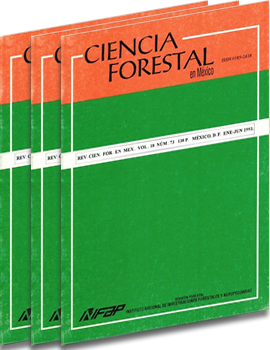EFECTO DEL FUEGO SOBRE ALGUNOS MICROORGANISMOS EN UN SITIO DE PLANTACIÓN FORESTAL
Keywords:
Prescribed forest fire, forest plantations, tropical forest, roza-tumba-quema, Quintana RooAbstract
This work was performed in a forest plantation area ofthe "San Felipe-Bacalar" Campo Experimental Forestal, at Quintana Roo.
Considering the importance of knowing the rnicrobiological behavior of soil when burning is used as a practice to prepare the plantation site.
Soil samples were obtained at two different depths (surface and 20 cm) with a periodicity of 15, 30, 60 and 120 days after buming, and a witness was kept (unbumt).
Samples were analyzed at the laboratory using the Stotzky methodology, which assesses the rate of CO2 released (mg/100 g of soil). Sorne soil microorganisms such as bacteria, fungi and actinomycetes were also quantified.
Results indicate that most microbiological activity of soil occurs at soil surface. Pire affects soil microbiology during the first 30 days after the burning takes place, with a fast recovery after such period.
Out of quantified microorganisms, bacteria were the most affected ones by fire; but they were also the ones with the highest growth after burning.
Downloads
Downloads
Published
How to Cite
Issue
Section
License
The authors who publish in Revista Mexicana de Ciencias Forestales accept the following conditions:
In accordance with copyright laws, Revista Mexicana de Ciencias Forestales recognizes and respects the authors’ moral right and ownership of property rights which will be transferred to the journal for dissemination in open access.
All the texts published by Revista Mexicana de Ciencias Forestales –with no exception– are distributed under a Creative Commons License Attribution-NonCommercial 4.0 International (CC BY-NC 4.0), which allows third parties to use the publication as long as the work’s authorship and its first publication in this journal are mentioned
The author(s) can enter into independent and additional contractual agreements for the nonexclusive distribution of the version of the article published in Revista Mexicana de Ciencias Forestales (for example, include it into an institutional repository or publish it in a book) as long as it is clearly and explicitly indicated that the work was published for the first time in Revista Mexicana de Ciencias Forestales.
For all the above, the authors shall send the form of Letter-transfer of Property Rights for the first publication duly filled in and signed by the author(s). This form must be sent as a PDF file to: ciencia.forestal2@inifap.gob.mx
This work is licensed under a Creative Commons Attribution-Noncommercial 4.0 International license.


